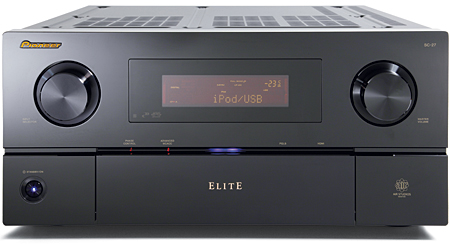Pioneer Elite SC-27 A/V Receiver
 Price: $2,200 At A Glance: MCACC room EQ makes it all good • ICEpower amplification is sweet, powerful, and dynamic • PQLS isn’t a gimmick; it really works
Price: $2,200 At A Glance: MCACC room EQ makes it all good • ICEpower amplification is sweet, powerful, and dynamic • PQLS isn’t a gimmick; it really works
What? No 8-Track?

I’m convinced that at a subatomic level, my DNA has begun mutating me into homo gadgetus. My dad was an electrical engineer, so naturally, hooking up a two-channel stereo was instinctual, hereditary, and manifest from the moment my little fingers could grasp an RCA connector. But setting up a multichannel, HDMI-equipped, Internet-connected AVR was a challenge until recently. I don’t think manufacturers have gotten that much better at their hardware and software design. I just think that as a subspecies (male), we’ve become more adept at new forms of hunting and gathering.
The Pioneer Elite SC-27 is the most refined AVR I’ve played with. It has every feature I could possibly want, implemented in ways that make them mostly easy to use. For instance, I simply plugged in the supplied microphone, and the SC-27 immediately brought up the Multichannel Acoustic Channel Calibration (MCACC) setup GUI. It did its job in just a few minutes. All I had to do was yell, “Hurry! Fire!” a few times to clear the house of the noisemakers and then press the Enter button on the remote a few times. Et voilà!
You can display and fuss with the MCACC’s nine-band room EQ curves, which show how well your speakers are response-matched in your listening environment. This is critical for achieving seamless surround sound in your theater room. Mark Peterson’s measurements of my Revel Voice2 center-channel speaker (which I reviewed for HT’s July 2009 issue and later bought) indicated a variance of less than 2 decibels from 200 hertz to 10 kilohertz. Still, my room is anything but a quasi-anechoic chamber, and the speaker needed a 7.5-dB boost at 250 Hz and a 9-dB cut at 50 Hz to bring it in line with the Salon2 speakers. I was far more impressed with the results from Pioneer’s MCACC than the Audyssey room-correction system in my Marantz SR8002 AVR, which I mostly left disengaged for my Revel review.
The SC-27 is the first AVR I’ve used that has two HDMI outputs that can be active simultaneously. This makes it much easier to operate a theater that has both a projector and a flat panel. There’s nothing worse than one of your theater users calling you in a panic while you’re at work on a busy Monday morning because you forgot to set the system back to Plasma after you used the projector last night, there’s no picture on the flat panel, and now the world is going to end if the Sunday-night Cake Boss marathon doesn’t magically appear. (I mean, come on, even if you weren’t good at Simon as a kid, you should still be able to master a simple eight-press button sequence, right?)
The SC-27 also has a complete set of video parameters for devices connected to the DVD, TV/SAT, DVR, VIDEO1, and VIDEO2 inputs. There are controls for sharpness, contrast, brightness, hue, and chroma, along with adjustments for output resolution and aspect ratio. While the manual doesn’t state as much, I suspect that these controls are only available for analog source material, with the KURO Link feature either on or off (more on that shortly); I couldn’t access the video parameter settings for my HDMI sources. Fortunately, anything I wanted to do in this regard is available on both of my display devices. That’s exactly where any video adjustments should be made, especially if you have two different display devices.
Mind Your PQLS!
I listen to a lot of music. In fact, I do more music listening than movie watching these days, so what the Pioneer can do for music is very important to me. For this review, I used a Pioneer BDP-320 Blu-ray player. It can synchronize its clock over HDMI with the one in the SC-27 for what Pioneer claims is jitter-free digital audio utilizing Pioneer’s Precision Quartz Lock System (PQLS). I conducted a few poor man’s A-B-X tests (you keep switching modes until you get confused and then pick which one you think sounds better). I correctly identified the PQLS system as superior, albeit slightly, in three out of three cases. I guess it works. On “Let’s Do the Things We Normally Do” from the Safe Trip Home CD, Dido’s voice became more focused, with more lower-frequency energy in her crooning. Bass was also more authoritative—but non-obviously so—with PQLS switched on.




























































